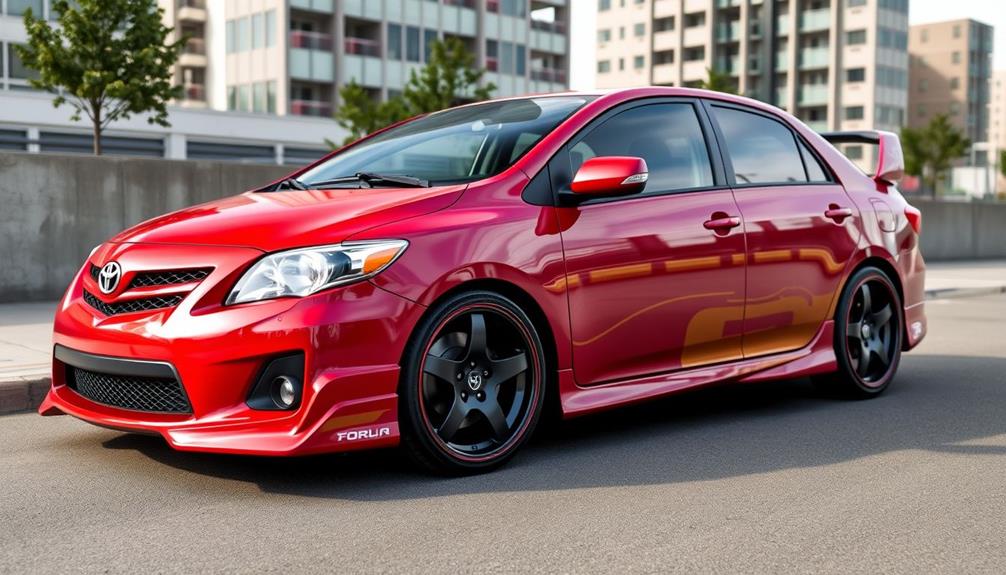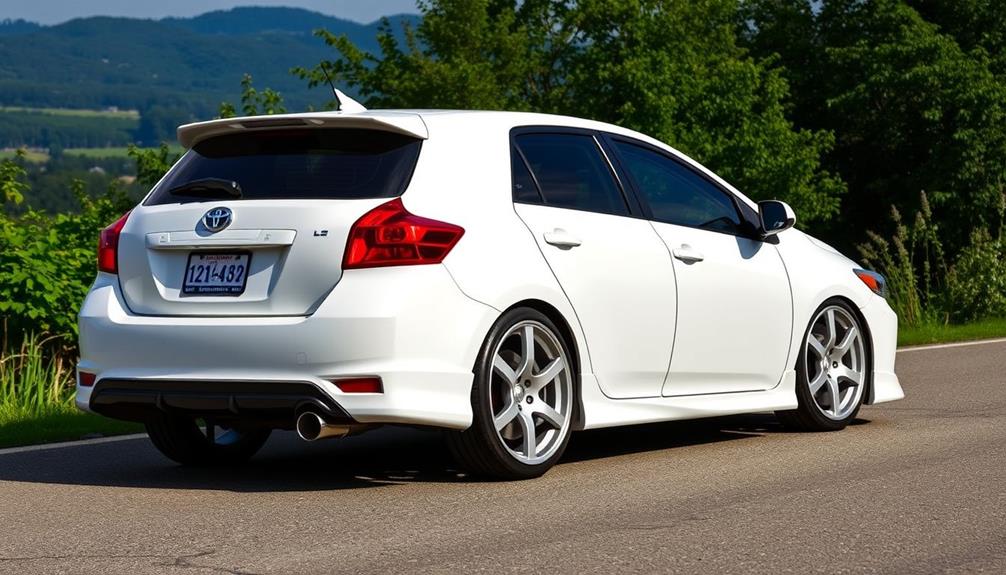To maximize power in your 2010 Toyota Corolla, start with a cold air intake system and a performance exhaust. These mods can add around 10-15 HP and improve throttle response. Consider a turbo kit for a more significant boost, especially for the 1.8L engine. Also, reducing weight by removing unnecessary components can enhance acceleration and handling. Just remember that while these upgrades can improve performance, they might strain your engine and increase maintenance needs. If you're curious about more effective tuning strategies, there are plenty of insights waiting to be uncovered. When tuning your Toyota Corolla for power, it’s also essential to consider upgrading the engine internals, such as the cams, pistons, and intake manifold. These modifications can significantly impact the engine’s power output and overall performance. Additionally, investing in a quality engine management system will help you tune and optimize your Corolla for maximum power safely and effectively. Don’t forget to consult with experts or professional tuners to ensure that your modifications are compatible and well-suited for your specific vehicle. When tuning your Toyota Corolla for power, it’s important to carefully research and select the right aftermarket parts and components. Upgrading your suspension and brakes can also help improve handling and overall driving performance. Furthermore, regular maintenance and tune-ups are crucial to keep your modified Corolla running smoothly and efficiently. By taking a comprehensive approach to tuning your Toyota Corolla for power, you can achieve a balanced and optimized combination of increased horsepower, better handling, and improved overall performance.
Key Takeaways
- Install a cold air intake and performance exhaust system to enhance airflow, potentially increasing horsepower by 10-15 HP.
- Consider a turbo kit for significant horsepower boosts, with modified versions reaching around 165 HP, but be mindful of reliability.
- Focus on weight reduction by removing unnecessary seats or using lighter materials to improve acceleration and handling cost-effectively.
- Properly tune your vehicle after modifications using options like ECUTek to ensure optimal performance and engine communication.
- Engage with online communities for insights and recommendations on performance upgrades and the best sequence to apply them.
Performance Modifications Overview
When you think about tuning your 2010 Toyota Corolla, a range of performance modifications can make a noticeable difference.
One of the most effective upgrades you can make is installing a cold air intake. This simple addition enhances engine breathing, allowing for better airflow and potentially increasing horsepower by up to 10-15 HP when paired with a performance exhaust system from trusted brands like Borla or TRD.
Another significant modification is utilizing turbo kits designed for the Corolla's 1.8L engine. These can drastically boost horsepower, with some modified versions reaching around 165 HP.
If you're looking for a cost-effective way to improve performance, consider weight reduction strategies. Removing unnecessary seats or using lighter materials can enhance handling and acceleration without breaking the bank.
Engine Specifications and Options

The heart of the 2010 Toyota Corolla is its 1.8L 2ZR-FE engine, which delivers a solid 138 HP at 6,400 RPM and 126 lb-ft of torque at 4,400 RPM. This engine is designed for reliability and fuel efficiency, but if you're looking to boost performance, various engine specifications and options are available.
You can enhance your Corolla's power with aftermarket performance upgrades like cold air intakes and exhaust systems, potentially yielding an additional 10-15 HP. If you're feeling adventurous, consider installing turbo kits, which can greatly increase horsepower, reaching around 165 HP in modified variants.
Moreover, the 2ZR-FE engine's architecture is compatible with other Toyota engines, allowing for possible swaps with models like the RAV4 and Camry. However, keep in mind that these swaps require modifications for mounts and wiring.
While the stock engine is reliable, aggressive modifications may impact long-term durability and maintenance costs.
Risks of Performance Upgrades

When you consider performance upgrades for your Toyota Corolla 2010, keep in mind that these modifications can void your manufacturer warranty.
You might also face reliability concerns and higher maintenance costs as the stress on engine components increases.
It's crucial to weigh these risks before making any significant changes to your vehicle.
Warranty Voidance Risks
Modifying your 2010 Toyota Corolla for enhanced performance can seem appealing, but it comes with significant warranty voidance risks.
When you engage in performance upgrades, especially those affecting the engine or transmission, you could inadvertently void your manufacturer's warranty. Many manufacturers, including Toyota, are vigilant about aftermarket modifications and may flag your vehicle during routine diagnostics, which can lead to denied warranty claims.
Aggressive tuning, like installing a turbo kit or performance exhaust, heightens the risk of reliability issues, complicating any warranty claims you might need to make down the line.
Even changes to your vehicle's ECU, such as remapping or chip tuning, can trigger diagnostics that indicate modifications, putting your warranty coverage in jeopardy.
Before you make any aftermarket modifications, it's essential to carefully review your warranty terms. Consulting with your dealer beforehand can help you navigate these risks and guarantee you're not left without coverage when you need it most.
Reliability Concerns
Performance upgrades on your 2010 Toyota Corolla can greatly affect its reliability. While performance modifications can enhance power, they also introduce reliability concerns. Aggressive upgrades, like turbo kits or nitrous systems, can strain the stock engine and require careful planning. Additionally, using aftermarket parts without proper tuning may lead to miscommunication with the engine's ECU, which can diminish performance and cause damage.
Here's a breakdown of potential risks associated with various performance modifications:
| Modification Type | Reliability Impact |
|---|---|
| Turbo Kits | Increased stress, higher repair frequency |
| Aftermarket Exhaust | Potential for miscommunication with ECU |
| Performance Air Intake | May require more frequent maintenance |
These performance upgrades can void your warranty, putting you at risk financially if issues arise. Long-term reliability concerns also come into play, especially in harsh driving environments where dust can adversely affect high-performance engines. Weigh the benefits against the risks to ascertain your daily driver remains dependable.
Maintenance Cost Increases
Upgrading your 2010 Toyota Corolla for better performance might seem appealing, but it can lead to considerable increases in maintenance costs. Performance upgrades like turbo kits and aftermarket exhaust systems put added stress on your engine components, requiring more frequent servicing. This added demand can quickly escalate your maintenance costs.
Moreover, aggressive tuning and modifications can void your warranty. If something goes wrong, you could face hefty repair bills that you wouldn't have otherwise incurred. While you might enjoy the boost in horsepower initially, these modifications often compromise the vehicle's long-term reliability, leading to higher repair expenses over time.
Additionally, installing performance parts like downpipes and cold air intakes usually needs further tuning. This necessity for professional services or specialized equipment can add to your overall maintenance costs.
You'll also notice increased wear on tires and brakes, necessitating more frequent replacements, which further contributes to the rising maintenance costs.
Community Insights and Advice

When diving into the world of tuning your 2010 Toyota Corolla, connecting with online communities can be a game changer. Engaging in forums allows you to tap into valuable community insights from fellow Corolla owners. They often share their experiences with performance modifications, helping you avoid common pitfalls.
As the landscape of automotive technology evolves, it's crucial to stay informed about the latest trends in AI and machine learning, which are increasingly influencing vehicle performance and tuning strategies AI Ethicist Jobs.
Many enthusiasts recommend starting with basic upgrades like cold air intakes and exhaust systems. These modifications can yield noticeable power gains while maintaining reliability. Discussions in these communities emphasize the significance of proper tuning after making modifications. Users frequently report significant performance improvements with tuning options like ECUTek, so don't overlook this step.
Additionally, you'll find tips on weight reduction strategies, such as removing unnecessary components. This approach can enhance overall performance without breaking the bank.
It's also beneficial to learn about the order of modifications; for instance, prioritizing downpipe installations before other upgrades can lead to better outcomes.
Alternative Vehicles for Performance

If you're looking for performance alternatives to a modified Toyota Corolla, there are several exciting options out there.
You might consider sports cars like the Mazda MX-5 Miata or the Ford Mustang EcoBoost, both offering impressive power and handling.
Additionally, budget-friendly options like the Honda Civic Si or the Volkswagen Golf GTI could give you a sporty edge without breaking the bank.
Sports Car Alternatives
For car enthusiasts seeking performance without the high price tag of a traditional sports car, several compelling alternatives offer thrilling driving experiences.
The Mazda MX-5 Miata, for example, is a lightweight sports car that delivers responsive handling and a fun drive, achieving 0-60 mph in about 5.8 seconds with its 181 HP engine.
If you prefer a bit more power, the Ford Mustang EcoBoost features a turbocharged 2.3L engine that cranks out 310 HP, providing excellent acceleration and an engaging ride.
The Subaru BRZ stands out with its rear-wheel-drive layout and 228 HP engine, making it perfect for twisty roads.
If you're looking for something compact, the Honda Civic Si combines practicality with sportiness, thanks to its 1.5L turbocharged engine producing 205 HP.
Finally, the Toyota GR86 is a direct competitor to the BRZ, offering a similar 228 HP engine and a lightweight design that delivers an exhilarating driving experience.
These sports car alternatives not only provide performance but also keep your budget in check, allowing you to enjoy the thrill without breaking the bank.
Budget-Friendly Performance Options
Budget-friendly performance options can transform your driving experience without breaking the bank. Instead of pouring money into modifying your 2010 Toyota Corolla, consider a used sports car like the Mazda Miata or Nissan 240SX. These lightweight performance vehicles are renowned for their superior acceleration and handling, often available at a similar price point.
If you prefer a sedan, the Toyota Camry with a V6 engine strikes a great balance between reliability and performance, delivering more horsepower and torque than your Corolla. Additionally, the growing demand for transparency in private equity investments can also be paralleled in the auto industry, where consumers are increasingly seeking out vehicles that provide both performance and value for money informed decisions.
Another enticing alternative is lightweight performance vehicles like the Subaru BRZ or Toyota GR86, designed specifically for driving enjoyment. They not only improve acceleration but also offer a more engaging experience than a heavily modified Corolla.
Don't overlook motorcycles, either; they can provide notably better performance for a lower investment, often costing less than extensive modifications on your Corolla.
Lastly, hybrid options, such as the Toyota Prius Prime, can also fit the bill. With a sportier driving mode and improved power delivery, they offer enhanced performance without compromising fuel efficiency, making them smart budget-friendly performance options for your daily driving needs.
Lightweight Motorcycle Comparisons
Lightweight motorcycles present an exciting alternative for those seeking performance without the bulk of a car like the Toyota Corolla. With their superior power-to-weight ratios, these bikes can deliver thrilling acceleration and agility that many car enthusiasts crave.
Here's a quick comparison of some top lightweight motorcycles:
| Motorcycle | Power (HP) | Weight (lbs) |
|---|---|---|
| Kawasaki Ninja 400 | 45 | 366 |
| Yamaha YZF-R3 | 42 | 368 |
| Honda CBR500R | 47 | 425 |
| KTM RC 390 | 44 | 366 |
For instance, the Kawasaki Ninja 400 boasts 45 HP while weighing just 366 lbs, outperforming the Toyota Corolla's 138 HP regarding acceleration. The Yamaha YZF-R3 and KTM RC 390 also provide impressive handling and speed, often achieving 0-60 mph in just 3-4 seconds.
If you're a Toyota enthusiast looking for an exciting yet practical alternative, these lightweight motorcycles can offer you the performance you seek. For more helpful information, check out dedicated motorcycle and performance websites!
Enhancing Daily Driving Experience

To truly elevate your daily driving experience in a 2010 Toyota Corolla, contemplate a few key upgrades that can make a noticeable difference.
By focusing on performance enhancements and maintaining your vehicle, you'll enjoy a more responsive and engaging ride.
Here are some upgrades to contemplate:
- Performance Intake System: Installing a K&N filter or cold air intake can increase horsepower by 10-15 HP, enhancing throttle response.
- Lightweight Wheels: Opt for lightweight wheels like RPF1s to reduce rotational mass, improving acceleration and handling.
- Performance Tires: Upgrading to high-quality performance tires boosts grip and handling, making driving more enjoyable in different conditions.
- Regular Maintenance: Don't overlook the importance of oil changes and spark plug replacements to keep your engine running smoothly and reliably.
- Suspension Upgrades: Contemplate upgrading your suspension for better stability and comfort, especially on uneven roads.
With these enhancements, your Corolla won't only perform better but also provide a more fulfilling daily driving experience.
Embrace these upgrades, and you'll look forward to every drive!
Frequently Asked Questions
How to Get More Power Out of a Toyota Corolla?
To get more power out of your car, consider upgrading the intake and exhaust systems, installing a performance tuner, and reducing weight. For significant gains, explore turbo kits, but remember to plan carefully to maintain reliability.
Can a Toyota Corolla Be Tuned?
Think of your Corolla as a canvas. Yes, it can be tuned! With the right upgrades and tuning, you'll reveal its hidden potential, transforming your daily drive into a more vibrant and thrilling experience.
What Is the 0 to 60 Time for a 2010 Toyota Corolla?
The 2010 Toyota Corolla can accelerate from 0 to 60 mph in about 8.5 to 9.0 seconds. This time varies slightly based on factors like vehicle load, road conditions, and transmission type.
How to Make a Toyota Corolla More Fuel Efficient?
To boost your car's fuel efficiency, keep up with regular maintenance, check tire pressure, and remove excess weight. Also, consider driving smoothly and installing a high-flow air filter to enhance airflow and combustion efficiency.
Conclusion
Tuning your 2010 Toyota Corolla is like polishing a diamond; it reveals the brilliance hidden beneath the surface. By carefully selecting performance upgrades, you can transform your daily driver into a spirited performer while maintaining reliability. Just remember, every tweak is a brushstroke on your canvas, enhancing your ride's personality. Embrace the journey of improvement, and let your Corolla shine bright on the road, reflecting both your passion and the power you've unleashed.










